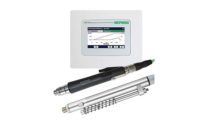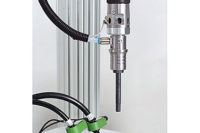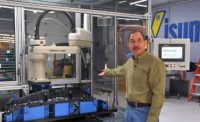In the spectrum of screwdriving automation, a semiautomatic screwdriving cell might seem like a compromise.
Certainly, using a handheld autofeed screwdriver to install screws is dramatically more productive than manually picking up a screw, inserting it into a part, and driving it home. On the opposite end of the spectrum, screwdriving operations are easily integrated into a multistation automated assembly system, as long as the production volume and expected product life cycle warrant the large capital outlay.
So when does it make sense to invest a semiautomatic screwdriving cell? “Any part with a good population of screws would be a candidate,” says Jack Keady, business development manager at Assembly Automation Industries. “Six to eight screws per part; 5,000 to 6,000 screws per shift. You want speed. If the parts will be manually loaded, you want the cell to be faster than an operator assembling the parts and installing the screws.”
“A semiautomatic screwdriving cell buys you half an operator’s time for free,” adds Jim Graham, president of Weber Screwdriving Systems Inc. “Whenever they’re not loading or unloading parts, they can be doing other tasks. They can be doing preassembly, labeling, packaging—a lot of secondary tasks can happen during that ‘quiet phase’ while the cell is installing screws.”
Quality and consistency are other reasons to invest in a semiautomatic screwdriving cell. “With people, there’s more variability in process control,” says Graham. “With a screwdriving cell, you can be sure that all the screws were installed and that torque, angle and depth specifications were met. And, you can export all that data for traceability.”
Indeed, a need to increase product quality was the primary motivation behind one company’s decision to purchase a screwdriving cell from Visumatic Industrial Products.
“The part had deep pockets for the screws, as well as openings for other functions,” recalls Jarrod Neff, marketing manager at Visumatic. “If an operator dropped a screw, it could fall into one of these openings. An autofeed screwdriver mounted to a robot solved the problem.”
On the other hand, a semiautomatic screwdriving cell may not be the best option for high-mix production.
“Manufacturing is trending toward small batches,” says Graham. “The Holy Grail is batch count one. Robots take a back seat when it comes to that. People are the most dexterous and flexible assembly machines.”
Cell Components
The heart of a semiautomatic screwdriving cell is, of course, the screwdriver (electric or pneumatic) and a screwfeeder (feeder bowl, tubing, and jaws to accept the screw). Some automatic screwdriving vendors have their own line of drivers. Others integrate drivers from third parties.
The driver can be mounted to a linear actuator or to a Cartesian, SCARA or six-axis robot.
There are several options for getting parts into the cell. The operator can load the parts directly into the work area of the machine. Or, for safety reasons, the operator can load the parts outside of the cell, in a fixture attached to a linear slide. When the cell is activated, the slide shuttles the fixture into the work area.
A third option would be a rotary indexing table. In the simplest arrangement, the table would index 180 degrees. This allows an operator to load and unload parts while screws are being installed on the opposite side. A rotary indexing table is also a good option if secondary operations, such as leak testing, will need to be performed.
The fixtures for a screwdriving cell vary with the application. For a relatively flat assembly, such as a modem or an electronic control module, the fixture might simply be a frame made from steel or ultra high molecular weight polyethylene. An assembly with a more complex shape, such as a steering wheel hub assembly, will require a fixture that matches its angles, curves and contours.
Either way, the fixture should be designed so that the part can only be inserted one way. The goal is to present the parts accurately and repeatably to the screwdriver.
“Hole locations need to be held to fairly close tolerances—±0.015 inch—for the cell to be successful,” says Kevin Buckner, director of engineering at Design Tool Inc. “When engineers look to automate, they need to do everything they can to ensure that hole locations are consistent.”
Sensors can be added to a fixture to ensure that all the parts are present and seated correctly. If the parts cannot be positioned consistently, the cell can be equipped with a vision system to locate the parts more precisely, says Graham. However, machine vision will increase the cost and complexity of the cell, and it will increase cycle time.
Visumatic recently designed a servo-driven tilting fixture for a headlamp assembly. “The lamp had this dramatic sweeping arc, which put the screws in different drive planes,” recalls Neff. “We either had to use a six-axis robot, so we could tilt the driver, or we had to move the part. In the end, it was easier to tilt the fixture than it was to tilt the driver.”
One advantage of a semiautomatic system is that more than one screwdriver can be bundled together so multiple screws can be installed simultaneously. Arrangements of two to six spindles are common.
Depending on the screw, the spindles can be located fairly close together, up to 0.625 inch center to center. “If you need to get closer than that, you can go to offset tooling,” says Keady. “With smaller screws, like M2, [the center to center distance] can be extremely tight.”
A multispindle arrangement can be important not just for cycle time, but for maintaining joint integrity, as well. For example, if the joint includes a gasket, the ability to drive multiple screws simultaneously can ensure a good seal and even compression.
A multispindle arrangement can also be used to fasten more than one assembly at a time. For example, Design Tool once built a three-spindle system that simultaneously installed screws into three small circuit boards. With each cycle, the machine produced three completed assemblies.
Although his company has built many multispindle setups over the years, Graham advises engineers to consider product life cycle before committing to such a system.
“To some extent, multispindle technology has had its day,” he says. “These systems are designed to install multiple screws very quickly—10 screws in 3 seconds. But the one thing you can’t do is change your part. …A single spindle mounted to a robot is much more flexible.”
Design Considerations
As with any automated assembly technology, good part design is critical for success, says Buckner. For example, engineers may need to design a feature in a cast or molded part to help locate it in the fixture. A chamfer around the hole can help guide the screw into the assembly. Similarly, fasteners with dog points or tapered points also facilitate automatic screwdriving.
One variable that can create trouble is the fit and finish of the parts, says Graham. For example, springs, wave washers and gaskets are the enemy of semiautomatic screwdriving cells. For one thing, the parts can shift the moment the operator releases the assembly.
“You don’t want the screws to be drawing the parts together,” says Graham. “In many cases, we’ll clamp the part prior to driving the screwdrivers to take out the variability in depth or size. We’re trying to get the screws to do their real job, which is to set up tension within the fastener. You don’t want to waste valuable torque energy squeezing the joint together.”
Access for the driver and tooling is also important. “If I can’t take a pencil and put it down into the hole I’m trying to target without anything getting in the way, it doesn’t bode well for automated assembly,” says Graham. “[If there’s not enough room for the tooling], it forces us to stay farther away from the assembly. It forces us to use vacuum or magnetics to hold the screw, rather than controlling the screw with tooling.”
Putting It All Together
Design Tool recently built a semiautomatic screwdriving cell that included a rotary indexing table. The system was built to install 10 screws around the cover of an electronics assembly. The cover and the housing are made of die-cast aluminum. A rubber gasket is sandwiched between the cover and the housing.
Pneumatic swing clamps are used to push down on the cover and compress the gasket prior to installing the screws. Five pneumatic screwdrivers, bundled together on a single platen, install five screws on one side of the cover. The table indexes 180 degrees, and the process repeats on the other side. A pneumatic linear actuator moves the drivers up and down.
All five drivers are fed out of one vibratory bowl supplemented with a 1-cubic-foot supply hopper.
A 60-gallon air tank below the work area ensures the cell will have a consistent volume of pressurized air. “We were installing thread-cutting screws, so we had to use larger pneumatic screwdrivers to meet the required torque,” says Buckner. “With five drivers running simultaneously, plus the feed system and the actuator, you need a large volume of air. A surge tank ensures that no device gets starved.”








